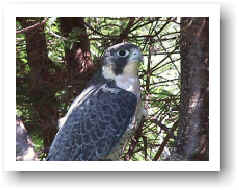
Peregrine Falcon
Falco peregrinus anatum
Status
Peregrine Falcons are native to Labrador; winter migrant to Newfoundland.
Habitat
Peregrines prefer coastal and inland cliffs and adjacent country, especially in the area of seabird colonies. They prefer open country, particularly shores and marshes where shorebirds and waterfowl are plentiful. They will occasionally occupy large cities.
Range
Peregrines are distributed throughout Canada; they winter in South America.
Food
Species preys almost exclusively on birds, from small songbirds to ducks. They will also feed on small mammals such as bats and voles, and occasionally on amphibians and even insects.
Predators/Threats
Peregrines have few enemies. However, the impact on their food chain by pesticides such as DDT has resulted in a sharp decline in their numbers, which subsequently resulted in their being considered “endangered” in most parts of the world in recent years. (See Notes).
Lifespan
The peregrine will live 12-18 years in the wild.
Appearance
Top and sides of head are dark slate which extends down to well-defined moustache mark. Upper parts are generally dark bluish-ash, barred with dark slate. Under- parts are buffy white to pinkish with blackish brown bars on sides and thighs and spots on abdomen. Tail is barred blackish and tipped whitish.
Breeding Biology
Three to five eggs are l aid on a cliff edge (occasionally in broken top of large tree or on a ledge of a tall city building). Eggs are cream colored with dark reddish-brown markings. Incubation by both sexes takes 33-35 days.
Weight/Measurements
Adult male is 38-46 cm in length and weighs approximately 570 grams. Female is 46-54 cm in length and weighs approximately 910 grams.
Notes:
- In 1999, status was upgraded from endangered to threatened in Canada.
- The peregrine dives or “stoops” at is prey at speeds over 250 km/h.
- In 1972, DDT was banned for use in North America.
- Peregrines mate for life. However, in the event of death, the survivor will quickly find another mate.
At Salmonier Nature Park
- Display birds are those donated to the Park from approved captive breeding centres.
